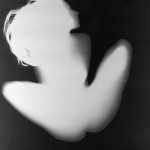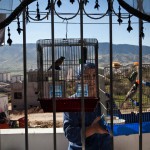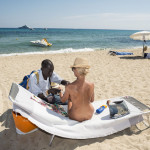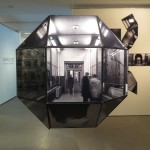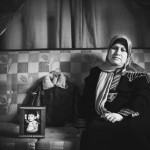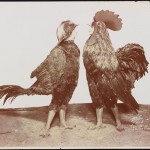Photography
Shuqin GuanThe capital of Bulgaria – Sofia – is full of an artistic atmosphere this summer. Wandering in the lush green public gardens of the city, you will easily encounter art.
At the Sofia City Garden and at the Crystal Garden you find two different exhibitions.
Exhibition in the City Garden | Madam Architect
You should definitely have seen the exhibition Madam Architect in the City Garden last July.
Madam Architect traced the work of female architects in Bulgaria and Germany. This exhibition presented twenty wonderful portraits of women who have contributed to architecture in both countries throughout the twentieth century. Like many other professional spheres, in architecture, women had to fight their way in a hostile environment to prove their talent and earn the right to an education and to a professional career.
Madam Architect was presented in Sofia by the Goethe-Institut, Bulgaria and the Bulgarian Modernist Architecture foundation.
The first section focused on German female architects and started the narrative by Emilie Winkelmann, the first freelance architect in Germany that ran an independent architecture practice in 1907. Many of the buildings designed by her, most of which were adapted to the individual needs of the residents, are now under historic preservation.
The timeline of this part of the German section spans German history since 1900, the Kaiserreich, the interwar years, the Third Reich, as well as the division of Germany and its reunification in the 21st century.
The Bulgarian section, on the other hand, only includes the years between the two world wars, and it is from this period that women were allowed into the conservative male sphere of architecture. Women in the construction industry faced a particularly unfriendly environment, which made it difficult for them to demonstrate their skills and earn access to educational opportunities and professional positions.
This exhibition explores the liberation movements of the 20th century, focusing on gender politics in particular. By breaking into traditionally male-dominated professions, getting involved in politics, and experimenting with new gender roles, women entered into modernism in which class, gender, knowledge struggles, senselessness, and alienation are all part of the conversation.
A focus of the exhibition is the past and present of women architects, their achievements in architecture, their lives, and their struggle to survive. A wide range of archival materials is displayed in the exhibition, including portrait photographs, hand-drawn projects, floor plans, sketches, and decorative drawings. By putting faces to names and sharing their experiences, these women in architecture are no longer anonymous and can voice their ideas.
The world’s female population is approximately 50%, and as equal stakeholders, their voices must be heard and encouraged. In this context, by highlighting the experiences and pursuits of these remarkable female architects, it is not only motivating other women to explore their own roles but also shedding more light on the present difficulties of gender equality in the workplace. Such a review of the past is also a good tool to better understand the present and future. Does the situation still exist? Why does this still happen? What should we do to voice and fight? How can we make them visible? Maybe these are the questions we should ask.
Exhibition in the Crystal Garden | The Beauty of Croatia
A photography exhibition opened at the Crystal Garden on a fine Monday afternoon, July 11. Presenting 26 amazing artworks by Croatia photographer Marko Vrdoljak, who has worked for many years on promoting the beauty of Croatia to the world.
The beauty of Croatia exhibition is one of the activities to commemorate the 30th anniversary of establishing bilateral diplomatic relations between Bulgaria and Croatia. With 26 images from around Croatia, the exhibition narrates a story of world-famous places and lesser-known locations. Providing a glimpse into the culture, history, and natural heritage of a relatively small country.
Experiencing some tough times and restrictions during the pandemic, these exhibitions also give fresh energy to the communities and inspiration for people enjoying their summertime. [...]
Read more...
Renata Procopio“The Amazon forest is the prehistory of humanity, the paradise on Earth“, declared Salgado at the presentation to the press with his new exhibition through which he wants to awaken “consciences“. The exhibition is the result of a seven-year journey through the largest tropical forest in the world.
The work introduces a clear and militant message: “We all have to fight” and “help the Brazilian resistance movements” to stop deforestation, he said, denouncing that the government of President Jair Bolsonaro is trying to “appropriate indigenous territories and national parks” to develop new agricultural extensions.
Launched on May 20 at the Paris Philharmonic, the show will travel to cities such as London and Rome, as well as São Paulo and Rio de Janeiro.
“Amazonia” is undoubtedly his most personal and vindicating work. Salgado, 77, had intended to invite indigenous leaders to the opening to make their voices heard against the destruction of their habitat and its consequences for the planet, which he still hopes to do once the pandemic allows.
The journey is followed by music composed especially for the occasion by the French musician Jean-Michel Jarre, one of the pioneers of electronic music, who adds: “the exhibition could have been the work of a documentary filmmaker, but it is the work of an artist. Salgado invites us to a mystical walk, which is what we need now that we are starting to come out of this pandemic.”
Amazônia is the saga of the Indigenous communities, portrayed on the ground floor, in their daily lives, and at the same time the jungle as it has rarely been seen, photographed from aeroplanes and helicopters.
The photographer reminds us that starting with water, with the Amazon and its affluents that snake across the land for thousands of kilometres, the so-called “flying rivers” – enormous torrents of steam that form over the forest – and the torrential rains, which in Salgado‘s photographs seem capable of immersing the observer.
“The indigenous people are us. When you go to work with indigenous communities, you are with your community, the community of Homo sapiens,” he says. “But it is a protected community, which has not been violated, which has not had the influences of the great religious currents or the deformations imposed by the limits of the states, nor by the domination of capital or politics. They are free beings! They live in peace“. At another moment he affirms: “That world is close to the initial concept of what for us is paradise. Paradise exists! Imagine that you wake up and can go hunting or not, go fishing or not, sleep whenever you want” ( Extract).
The editor Taschen is publishing Amazonia in book format. And until the end of October an exhibition of the same name is on show at the City of Music in Paris. Both book and exhibition were conceived and edited by Lélia Wanick Salgado.
https://www.instagram.com/p/CPI0SAijJRT/ [...]
Read more...
Thomas BüschWe mourn the former art university professor Floris Neusüss, professor at the art university in Kassel, who died on April 1st at the age of 83. He was one of the most innovative photographers of the past six decades in Germany and is considered one of the main representatives of experimental photography in Germany.
Floris Neusüss was a contemporary experimental photographer known for his use of camera-less photography (photograms). His most famous works are the Nudogramms from the late 1960s, in which he exposed a nude figure directly onto photographic paper “Photograms don’t show us what’s beyond the visible, but they give us a hint of it,” Neusüss has said. “It is true that the subject resting on the photo-sensitive paper presents its reverse side to be recorded, the side that is in shadow, the shadow cast by the object itself. This intimate physical connection inscribes into the paper, and this, if you are open to it, is the real fascination of photograms: the tension between the hidden and the revealed.
[...]
Read more...
Thomas BüschDEPO Istanbul, a space for critical debate and cultural exchange, presents until 12 March 2017 the exhibition Mekân: Stories of Syrian Refugees by NarPhotos Collective.
Twelve photographers from NarPhotos Collective, took photos in Syria, Iraq, Turkey, Greece and Germany since the beginning of the civil war in 2011, and turned them into features which trace different themes relating to Syrian refugees. The exhibition includes 54 photographs compiled from those photo stories.
Through each photo we witness the lives of civilians who are exposed to the most severe consequences of the crisis; to their dangerous journeys, time in refugee camps and struggles in big cities, to the families who try to stay together, to young people and children.
The word “Mekân” in the title, is a Turkish word of Arabic origin which is frequently used and it translates as “space of existence, place”. Its connotative meanings also include “home, locale”. Human mobility which increases with the escalating violence particularly in the Middle East, makes us rethink all the senses and associations of this word.
Considered as the biggest migration wave since the Second World War, the strenuous journeys of Syrian civilians render the questioning of all the human made borders necessary in order to be able to make a different world possible. “Mekân” includes the visual testimonies of NarPhotos photographers who wish to contribute to this process of questioning.
Nar Photos Collective is an independent collective based in Istanbul by photographers for whom documentary photography is a visual tool of “understanding and expressing” the world. Nar Photos brings together the diverse viewpoints in Turkey through their egalitarian, democratic approach and their stance for freedom since 2003 until the present. The collective covered beside other subjects the Gezi Protests in Istanbul, the mine disaster in Soma or Yazidis Escaping the Islamic State. Their works were also on display 2014 in the exhibition On the Road at Istanbul Modern.
Address:
DEPO / Tütün Deposu Lüleci Hendek Caddesi No.12
Tophane 34425 İstanbul
until March 12th [...]
Read more...
Thomas BüschAn unnamed gunman gestures after shooting the Russian Ambassador to Turkey, Andrei Karlov, at a photo gallery in Ankara, Turkey, Monday, Dec. 19, 2016. A gunman opened fire on Russia’s ambassador to Turkey at a photo exhibition on Monday.
Jerry Saltz considered in VULTURE magazine the photographs of the assassination of the Russian ambassador at an art gallery in Ankara Photos As History Painting. He says in his article, they poses are almost classical, frozen, or rehearsed as if from theater, ballet, painting, or mannequin display.
For Saltz everything in the images is emotion articulated, caught, performed, and real. All of this triggers an unreal internal visual dance. It’s a new surrealism of modern life, made all the more harrowing because it could not be more truly real.
The photos were taken by Associated Press photographer Burhan Ozbilici, who clearly has the eye of a professional. He has a professional’s ethos, too. And he does take pictures. Remarkable ones.
Read the whole text at VULTURE!
Photo: Burhan Ozbilici/Turkey/AP
The idea of Photos as History Paintings is one attempt of a rationalization of the irrationality of current affairs in the field of the esthetics. Poses like the one of the assassin of the Russian embassador in Ankara have something of a Pars pro toto. A narcisstic pose of power abuse, fatal and lethal violent, dramatized godlike and in a terrible way infantile. The individual acting as part of a collective narcissim claiming to be on the right and divine path. Some artists are working on methods of a recontextualization by reenactments of poses like the Austrian artist group “G.R.A.M.” (http://www.inenart.eu/?p=19433) or reenacting interpretations and fusions like Japanese appropriation artist Yasumasa Morimura (http://exhibitions.warhol.org/morimura/ ).
[...]
Read more...
Thomas BüschFor decades Angela Fensch has been concerned with studying her subjects long-term. In everyday surroundings she internationally stages photographic images of her subjects, portraying the atmosphere of their lives.
Angela Fench has been taking photos since she was 19 years old. She modeled at the Fashion Institute of the GDR, earned a degree and later on studied photography. As a freelancer she works for various magazines and her exhibitions in Germany and abroad are based on the photo books she produces.
[...]
Read more...
Thomas BüschSaint Tropez, France, August 30, 2013
A Senegalese migrant sells a bracelet to a naked lady on a naturist strech of Pampelonne Beach in Saint Tropez.
As soon as one reaches the open waters it can become difficult to imagine the landscapes out of sight. In case of the Mediterranean Sea, there is much to imagine: the European shores, the ones of the Middle East and the Maghreb’s. With „The Continuity of Man“ Belgian artist Nick Hannes now presents a photo series depicting the multiple ways of life along these shores.
She is sitting on her beach lounger, sunglasses, a hat, dyed blond hair. She is not young anymore as the wrinkled, hanging skin on her back indicates. She is nudely enjoying herself and the sea at Pampelonne Beach in Saint Tropez. Next to her there is a man on his knees in the sand. Completely dressed, carrying a backpack with his goods. He is from Senegal, offering necklesses and bracelets for small money. He hopes to earn something out of the naked women he has to look up at hierarchically.
It is irritating photos like this one that Nick Hannes has been shooting around the Mediterranean Sea during four years. He travelled the riparian states and captured multiple moments on almost all egdes of this water. When he started in 2010, the Arab spring had not started yet, Lampedusa was not as famous yet. The duration and massive dimensions of the Greek crisis were not foreseeable yet. The unpleasant tide of events cynically made his project even more thrilling.
His photos are depicting the outcomes of mass tourism in Spain, France, Turkey and Croatia, and show contrarily how illegal immigrants are taking their first bath in the waves in Lampedusa. One can see how a Greek celebrates – for monetary reasons – his wedding at the petrol station he ownes and how a young unconscious Egyptian who was hit by tear gas is being carried away in Cairo. In Algier a desperate old man is sitting on an anchor next to the sea, while the well-offs in Monaco are bored on their sailing yacht.
This all happens along the same waters, although it may be hard to believe in some cases. It took Hannes 18 months abroad to shoot the pictures which are now „The Continuity of Man: A portrait of the Mediterranean Region“. He travelled all the regions that ages ago belonged to the Roman’s empire – they were the first and only to control the entire coastline. They called it „Mare Nostrum“ – „Our Sea“ – and built a political unity around the waters, which were always being sailed, traded upon, fought for.
By now nothing reminds of the former entity anymore. In his works Nick Hannes specifically focusses on mass tourism, urbanisation, religion, migration and conflicts. „Monaco and Gaza are both situated on the shores of the same sea“, he states. „This project is about the paradox of this region, about the parallel existances that are emerging here – and about the multiple faces of the Med.“
With „The Continuity of Man“ Hannes catches authentic moments of a variegated region that should make especially European tourists think of their destinations. His photos show impressively a compilation of those places that one might lose sight of on the high seas.
„Mediterranean: The Continuity of Man“ can be purchased as book on Amazon and are currently displayed at the Thessaloniki Biennial until 15th of September 2015.
[...]
Read more...
Thomas BüschBook Launch and Exhibition – the upcoming artist in residency from Berlin in Istanbul will have a book launch and exhibition in Berlin, February 19th 2015, 7 pm at Revolver Publishing Immanuelkirchstraße 12, Berlin. Katja Pratschke together with her husband, the filmmaker and artist Gusztáv Hámos will be in Istanbul starting in March 2015:
The exhibition Sample Cities / Imaginary Spaces deals with the theme of personal urban perceptions, which we call »the city«. The city, as a living organism, reflects social processes and interactions, economic relations, political conditions and private matters. In the city, human memories, desires and tragedies find expression in the form of designations and marks engraved in house walls and paving slabs. The Sample Cities/ imaginary spaces project researches what is contained or concealed in the city under this layer of signs.
The source material for the installation consists of photo works by Gusztáv Hámos, produced between 1973 and 2012, each of which sequences depicts essential situations of urban experiences containing concentrations of human and inhuman acts in a compact form. The cities in this exhibition include Berlin, Budapest and New York. Places with a traumatised past: (cold) war, dictatorships and terrorist catastrophes.
For the exhibition, 9 photo sequences have been assembled into tableaux or series of images and a three dimensional photo object. Every individual photo work already contains within it an idea, an arrangement, a programme, a concept – as scores and notations. Sample CitIES/ imaginary spaces is inspired by Italo Calvino’s book »La città invisibili«, (»Invisible Cities«). Each video outlines an imaginary city that summarises an historic, social, economic, political or private aspect in a poetic narrative.
Video Credits: Narrator – Ulrich Matthes | Music – Chopin | Drums – Thomas Wydler | Vocals – Karolina Ferencz
Learn more about Hidden Cities and Sample Cities at potentialspace by Gusztáv Hámos and Katja Pratschke.
Katja Pratschke is the artist in residence in Istanbul by the Berlin Senat starting March 2015 – .
[...]
Read more...
Thomas BüschPhotography Challenges History
The Martin-Gropius-Bau in Berlin shows in the frame of the European Month of Photography the exhibition Memory Lab: The Sentimental Turn. The exhibition deals with questions how are historical events, cultural characteristics and changes in social conditions portrayed by today’s artists and photographers who use the mediums of photography and video? How is the distance between then and now, between current living conditions and the object of interest photographically constructed and what “reality” is being presented? How is memory formulated and how does this counteract the act of forgetting?
Aura Rosenberg: Eye with Rubble, 2013
In the past two decades, a type of photography has established itself that explicitly turns away from the long time prevailing principles of documentary photography, photojournalism, strait and street photography. The photographer sets an emotionally charged gaze against objectivity and objective visualization based strategies.
This type of photography is often playful and implements the entire medium in order to stimulate an emotional reaction. The photographer aims to be touching and poignant. The artists included in the exhibition often tell stories through photo series and work often with essayistic elements.
With their work they want to wake up, involve people and take a closer look at the history by analizing it with emotional competences. One of these artists is Vera Frenkel from Canada. The exhibition shows for the first time in Europe her series The Blue Train (2012) – a complex ensemble of large screens, photographs, and tablet computers. In 32 short films, Frenkel condenses observations and creates typical scenes from everyday occurrences during the fictional train journey. In her work she addresses the story of her mother, who fled to London from the former Czech Republic in 1939 and creates a parallel to the memories of Werner Wolff, a Jewish photographer who emigrated from Germany to the US. The two journeys through pre- and post-war Europe and the images connected to them are shown in close proximity in a large-scale simultaneous video presentation. They overlap and merge into one another like palimpsests to form exemplary motifs; they repeat, vanish, and reappear in the form of memory shreds of events that have been written or passed down orally.
Vera Frenkel – The Novelist
Vera Frenkel – The Sergeant
The artists selected by the Month of Photography Berlin together with the European partner cities for the joint exhibition MemoryLab seek to stir things up with their images, to involve the viewer. They want to break history open and analyze it with emotional competence. They work in essay form, developing photographic series and narrative videos.
The European Month of Photography Berlin is one of the biggest German Photo festival and celebrates this year its ten-year anniversary. Every second year they present numerous exhibitions and events to the topic historical and contemporary photography art. It is organized by the Kulturprojekte Berlin GmbH in cooperation with museums, cultural institutions, galleries, embassies and universities of Berlin and Potsdam.
PARTICIPATING ARTISTS
(as of July 2014)
Andreas Mühe (Germany, Karl-Marx-Stadt, lives in Berlin),
Vera Frenkel (Slovakia, Bratislava, lives in Kanada, Toronto),
Pablo Zuleta-Zahr (Chile, Vina del Mar, lives in Berlin),
Erwin Olaf (Netherlands, Hilversum, lives in Amsterdam),
Aura Rosenberg (USA, New York, lives in New York and Berlin),
Nan Goldin (USA, Washington D.C., lives in Paris and Berlin),
Broomberg & Chanarin (Southafrica, Johannesburg/GB, London, lives in London),
Nasan Tur (Germany, Offenbach, lives in Berlin and Rome),
Stephanie Kloss (Germany, Karlsruhe, lives in Berlin),
Antoine d’Agata (France, Marseille),
Klaus Mettig (Germany, Brandenburg, lives in Düsseldorf),
Anna Charlotte Schmid (Germany, Essen, lives in Berlin),
Marko Lipuš (Austria, Eisenkappel, lives in Vienna),
Attila Floszmann (Hungary, Budapest),
Tomáš Šoltýs (Slovakia, Prešov, lives in Austria, Vienna)
Trevor Paglen (USA, Maryland, lives in New York)
Duration: Oct 17 – Dec 15, 2014
Location: Martin-Gropius-Bau, Niederkirchnerstraße 7, 10963 Berlin
Admission free.
[...]
Read more...
Thomas BüschNothing replaces the loss of a son, not even another son. Those are the haunting words of Safia Abo Zour, a Palestinian woman whose four-year-old died in a 2011 airstrike in Gaza. In a portrait by photojournalist Eman Mohammed, Safia Abo Zour has one hand wrapped around her five-month-old; in her other hand, she holds the sweater that her older son wore the last time he went to kindergarten.
Eman Mohammed’s current work focuses on the Israeli/Palestinian conflict. It’s never especially chipper, but her newest project, iWar, is particularly grim. The collection, Eman Mohammed’s first set of portraits, forces you to confront the Gaza wars through the eyes of the survivors, away from the carnage, in deliberate black-and-white interiors, stark and quiet. Each photo features a person who lost someone in the wars, posed with an abandoned relic to show their absence. In a way, the domesticity of everyday life is more unnerving than the violence.
iWar is a work in progress, to be completed in summer 2015. Eman Mohammed will next turn her focus to survivors of the September 11th attack in New York, and then to Holocaust survivors. Though these may be unexpected subjects for a Palestinian Muslim, says Eman Mohammed, she believes pain makes for the strongest connection between people. She says, Pain has no nation. The violence keeps going in a circle. That should be enough to stop future manmade disasters.
Compilation from TED Magazine written by Thu-Huong Ha. [...]
Read more...
Thomas BüschBack in 1911, one of the most talked-about Broadway roles was played by a woman dressed as a rooster, and now you can revisit the surreal staging with recently digitized photographs from the Museum of the City of New York.
The Museum of the City of New York has taken on digitizing over 30,000 images of more than 5,000 Broadway shows from their theater production archives.
These selection of photos display a 1911 Broadway production of Chantecler. The show features only animal characters, centering on a rooster named Chantecler who believes his morning song brings the dawn. A pheasant in the forest attempts to win his love, but his heart ends up staying with the farm.
The show was wildly popular with the public, touring to 60 cities outside New York.
Compilation from Hyperallergic [...]
Read more...
Johanna FröhlichThe Berlin based photographer Kai Wiedenhöfer spend several times in Gaza taking photos that do more than underlining a story. His pictures are capable of telling a story documenting in almost unbearable detail the damage left after Israel’s assault on Gaza in 2009. He has worked in this area for more than 20 years and has specialized on military destructions of houses and the lives that they host.
Wiedenhöfer’s book and exhibition The Book of Destruction supported by the Fondation Carmignac Gestion depicts the suffering of the civilian population in a terrifying aesthetic but sustainable way that leaves a lasting impression. Quiet, clean and elegant panoramic images of destroyed buildings show the extent of the bombings. Also there are portraits of maimed people in the book that illustrate the remaining wounds of the bombings and serve as a reminder that war in the 21st century is as real and terrible as the wars that entered into history.
His human subjects look into the camera, seated in their own homes: women and children; the family of fighters and civilians – all displaying bewildering variations of traumatic amputation and burns.
The photographs of the ruined buildings supply their own taxonomy of the consequences of different explosive forces: houses brought down by mines rendered into bristling igloos of concrete; buildings pierced and burned by shells; walls perforated by gunfire. The result is a body of work that is anti-sensational but shocking in the directness with which it engages with violence.
[...]
Read more...



